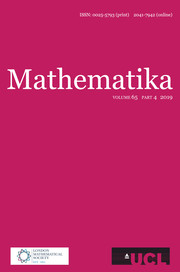Crossref Citations
This article has been cited by the following publications. This list is generated based on data provided by Crossref.
Harman, Glyn
and
Kumchev, Angel
2010.
On sums of squares of primes II.
Journal of Number Theory,
Vol. 130,
Issue. 9,
p.
1969.
Sun, Haiwei
2011.
The values of additive forms at prime arguments.
Studia Scientiarum Mathematicarum Hungarica,
Vol. 48,
Issue. 4,
p.
421.
Li, Weiping
and
Wang, Tianze
2011.
Diophantine approximation with one prime and three squares of primes.
The Ramanujan Journal,
Vol. 25,
Issue. 3,
p.
343.
Liu, Zhixin
and
Sun, Haiwei
2013.
Diophantine approximation with one prime and three squares of primes.
The Ramanujan Journal,
Vol. 30,
Issue. 3,
p.
327.
Mu, Quanwu
2016.
Diophantine approximation with four squares and one kth power of primes.
The Ramanujan Journal,
Vol. 39,
Issue. 3,
p.
481.
Wang, Yuchao
2016.
Diophantine approximation with two primes and powers of two.
The Ramanujan Journal,
Vol. 39,
Issue. 2,
p.
235.
Kumchev, Angel
and
Zhao, Lilu
2016.
ON SUMS OF FOUR SQUARES OF PRIMES.
Mathematika,
Vol. 62,
Issue. 2,
p.
348.
Wang, Yuchao
and
Yao, Weili
2017.
Diophantine approximation with one prime and three squares of primes.
Journal of Number Theory,
Vol. 180,
Issue. ,
p.
234.
Mu, Quanwu
and
Qu, Yunyun
2018.
A note on Diophantine approximation by unlike powers of primes.
International Journal of Number Theory,
Vol. 14,
Issue. 06,
p.
1651.
Liu, Huafeng
and
Huang, Jing
2019.
Diophantine Approximation with Mixed Powers of Primes.
Taiwanese Journal of Mathematics,
Vol. 23,
Issue. 5,
Ge, Wenxu
Zhao, Feng
and
Wang, Tianqin
2019.
On Diophantine approximation with one prime and three squares of primes.
Frontiers of Mathematics in China,
Vol. 14,
Issue. 4,
p.
761.
Zhu, Li
2020.
Diophantine inequality by unlike powers of primes.
The Ramanujan Journal,
Vol. 51,
Issue. 2,
p.
307.
Ge, Wenxu
Li, Weiping
and
Zhao, Feng
2020.
The integral part of a nonlinear form with a square, a cube and a biquadrate.
Open Mathematics,
Vol. 18,
Issue. 1,
p.
1272.
Qu, Yunyun
and
Zeng, Jiwen
2020.
Diophantine approximation with prime variables and mixed powers.
The Ramanujan Journal,
Vol. 52,
Issue. 3,
p.
625.
Liu, Huafeng
2021.
A note on Diophantine approximation with prime variables and mixed powers.
The Ramanujan Journal,
Vol. 56,
Issue. 1,
p.
249.
Liu, Yuhui
2021.
Diophantine approximation with mixed powers of primes.
The Ramanujan Journal,
Vol. 56,
Issue. 2,
p.
411.
Gambini, Alessandro
2021.
Diophantine approximation with one prime, two squares of primes and one kth power of a prime.
Open Mathematics,
Vol. 19,
Issue. 1,
p.
373.
Mu, Quanwu
Xi, Liyan
and
Wang, Tingting
2021.
A Diophantine Problem with Unlike Powers of Primes.
Journal of Mathematics,
Vol. 2021,
Issue. ,
p.
1.
Huang, Jing
Zhai, Wenguang
and
Zhang, Deyu
2021.
Diophantine inequalities over Piatetski-Shapiro primes.
Frontiers of Mathematics in China,
Vol. 16,
Issue. 3,
p.
749.
Liu, Huafeng
and
Yue, Jun
2022.
Diophantine approximation over primes with different powers.
Applied Mathematics and Computation,
Vol. 421,
Issue. ,
p.
126940.


